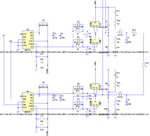RBN44
Newbie level 2
Hi, I'm having trouble with the ir2110 output. I'm working on a class d full bridge amplifier and I use 2 ir2110 to drive 4 irf540N mosfets. The switching frequency I use to generate the PWM is 240kHz and I include a 100ns deda-time (ideally would be no more than 50ns), but still got some peak in the output that generates shoothrough. In the picture you can see the circuit, that includes a snubber, the filter and load.

The porblem I need help with is that the deadtime is correct at the input of the ir2110, but in the output i get a peak (circled in red) which is causing the problem and I don't know what causes it.

Thanks in advance.

The porblem I need help with is that the deadtime is correct at the input of the ir2110, but in the output i get a peak (circled in red) which is causing the problem and I don't know what causes it.

Thanks in advance.